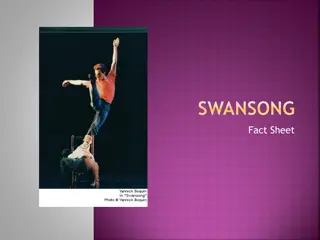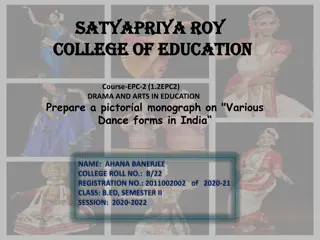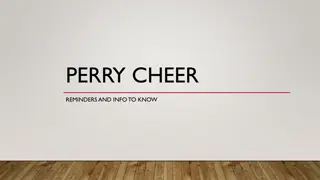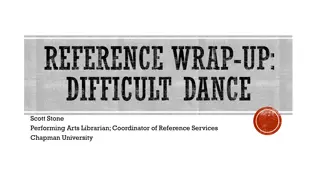Cheer and Dance Routine Judge Training Guide
This training guide provides essential information for judges in cheer and dance competitions, covering topics such as professionalism, accountability, recognizing difficulty, and competition divisions. It emphasizes the basic responsibilities of a routine judge, professionalism expectations, scoring guidelines, and definitions of various cheer categories. The guide offers insights on how judges can conduct themselves, evaluate performances, and ensure fairness throughout the competition.
Download Presentation

Please find below an Image/Link to download the presentation.
The content on the website is provided AS IS for your information and personal use only. It may not be sold, licensed, or shared on other websites without obtaining consent from the author.If you encounter any issues during the download, it is possible that the publisher has removed the file from their server.
You are allowed to download the files provided on this website for personal or commercial use, subject to the condition that they are used lawfully. All files are the property of their respective owners.
The content on the website is provided AS IS for your information and personal use only. It may not be sold, licensed, or shared on other websites without obtaining consent from the author.
E N D
Presentation Transcript
2023-24 Cheer and Dance Routine Judge training IHSAA
Training Outline The Basics Professionalism Accountability Recognizing and Rewarding Difficulty
The Basics Being hired as a routine judge carries responsibilities: Be knowledgeable. Be kind. Be respectful. Throw your history out the window. Be a student of your sport. Recognize the power you have.
COMPETITION DIVISIONS CHEER DIVISIONS** ALL GIRL COED CHEER CATEGORIES SHOW** SIDELINE POM DANCE CATEGORIES DANCE MILITARY HIP HOP POM
Professionalism for Judges Arrive at competition 1 hour before competition start time. When you arrive at the competition check in with the competition director. Do not visit with athletes, coaches or patrons. Dress professionally. Usually business casual is a good rule of thumb. Layers are a good idea for drafty gyms. Bring appropriate materials such as pencils, erasers, calculators (can use phone if it s in airplane mode), seat cushions, etc Most competitions will provide the basics but it s best to be prepared. Do not call, text, check social media or email in the judges area where you can be seen. Even if it s during a break in competition, it s NEVER ok. Go to the judges lounge or a private area to take care of personal matters. Do not, share your opinions, or make remarks of any kind, to patrons or coaches you may know. Even a Good Job to a coach passing you in the hallway can be misconstrued. You are being watched!
Professionalism cont. - Scoring Give appropriate scores. Do not inflate the scores. Consider the entire season. Teams are probably not 95-100 at the beginning of the season. Give them somewhere to go during the year. Do not tie teams. Do not go smaller than a .5. Leave enough space between your scores that you can squeeze someone in at the end if necessary without using a .25 or .75. Stay consistent throughout the day and throughout the category. The best team might perform first! Know how to spell and use the correct terminology. Bring a cheat sheet if necessary. Initial all changes you make to the judging sheet/scores. Choose whether you are going to write your comments on the back in paragraph form, list form, or + and lists. Are you going to write your comments only on the front? Don t look down at your sheet. Keep your head and eyes up, and try to look pleasant as you evaluate the routine. Number one priority JUSTIFY YOUR SCORE. Keep track of your scores within each category (re-cap sheet).
CHEER CATEGORIES WITH DEFINITIONS Show Cheer: Teams will be judged on execution, difficulty, incorporated skills, strength of motions, tumbling, jumps, overall entertainment. Sideline will be judged on jumps, cheer, crowd leading and overall. Pom is judged on dance, use of poms and the overall effect of the routine. Coed will be judged the same as the others. Please remember that just because there are boys, they still have to have technique and showmanship and strong arm motions. It s not about the height of a stunt with boys. Its everything.
DANCE CATEGORIES WITH DEFINITIONS Dance Routine emphasis: technique, style, interpretation. Not permitted: storylines, character development, costume changes, hand props, stage props, or backdrops. Military Routine emphasis is on precision, maneuvering, and formations. Costumes must be military style or generic school costumes. Not permitted: storylines, character development, costume changes, hand props, stage props, or backdrops. Hip Hop Routine emphasis: synchronization, technique, style, musicality. All aspects of the routine, including music, choreography, costuming and concept must be appropriate for public performance at the high school level. Permitted: hand props. Not permitted: stage props or backdrops. Pom Poms must be used for at least 75% of routine length and include all performing team members. Routine emphasis is on synchronization, visual effects and clean/precise motions. Visual effects include level changes, group work, opposing motions, formation changes, etc. Not Permitted: storylines, character development, costume changes, hand props other than poms, stage props or backdrops.
POSITIVE AND NEGATIVE WORDS WHEN JUDGING PLEASE REMEMBER TO LOOK AT THE POSTIVE ASPECT OF THE PERFORMANCE. YOU SHOULD NOTE AS MANY POSTIVIES ABOUT THE ROUTINE AS NEGATIVES OR IMPROVEMENTS. COACHES WANT TO KNOW WHAT TO IMPROVE ON SO BE SPECIFIC, AND BE ABLE TO JUSTIFY YOUR SCORE. WATCH YOUR WORDS. DON T ALWAYS USE THE WORD GREAT OR NICE .
JUDGING THESAURUS POSTITIVE GORGEOUS EXCELLENT SUPERB BRILLIANT MAGNIFICENT NEUTRAL PRETTY SOLID APPROPRIATE SUFFICIENT ENJOYABLE NEGATIVE WEAK LACKING POOR SLOPPY LACKS TECHNIQUE BREATHTAKING INSPIRING GENIUS PERFECTION AMAZING ADEQUATE GOOD NICE OK WELL DONE NEEDS FOCUS IMPROVE CLARIFY EXPAND MORE PRECISION
BIAS Coaches and athletes deserve judges who can set aside any preconceived notions or reputations and score the routine that is presented that day. Teams just want to feel that they are getting a fair shake. We all have history and relationships within the cheer/dance world ..that cannot come into play when judging. Be a fair and impartial judge. If you have the possibility of judging State, consider limiting the number of invitationals you work.
Accountability Regardless of what score you give, be ready to defend it. Your scoresheets must reflect what you see that day. At the end of each category, ask yourself Did I score the best team the highest? Am I rewarding difficulty? Am I being consistent? Am I putting enough emphasis on execution?
THE BIG QUESTION. DIFFICULTY vs. EXECUTION Each judge s tipping point will fall differently. It s a balancing act.
Difficulty What makes a routine difficult? Complexity Elite Stunting and tumbling (cheer) Unique and seamless transitions Full team vs Small Group Can you recognize it when you see it? This should be in the forefront of your mind while judging.
100 or 0? Do performances start at the highest point total and then lose, or get deducted, points as the routine goes along? OR . Do performances start at 0 and teams must earn points in each scoresheet category?
THANK YOU!!! DON T FORGET TO TURN IN YOUR JUDGE REGISTRATION FORM HAMMONSJ@IDHSAA.ORG























